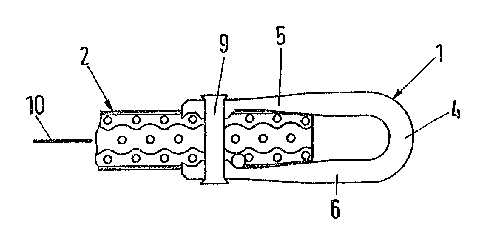Une partie des informations de ce site Web a été fournie par des sources externes. Le gouvernement du Canada n'assume aucune responsabilité concernant la précision, l'actualité ou la fiabilité des informations fournies par les sources externes. Les utilisateurs qui désirent employer cette information devraient consulter directement la source des informations. Le contenu fourni par les sources externes n'est pas assujetti aux exigences sur les langues officielles, la protection des renseignements personnels et l'accessibilité.
L'apparition de différences dans le texte et l'image des Revendications et de l'Abrégé dépend du moment auquel le document est publié. Les textes des Revendications et de l'Abrégé sont affichés :
| (12) Brevet: | (11) CA 2124918 |
|---|---|
| (54) Titre français: | AGRAFE POUR BANDE TRANSPORTEUSE |
| (54) Titre anglais: | FASTENER FOR CONVEYOR BELTS |
| Statut: | Durée expirée - au-delà du délai suivant l'octroi |
| (51) Classification internationale des brevets (CIB): |
|
|---|---|
| (72) Inventeurs : |
|
| (73) Titulaires : |
|
| (71) Demandeurs : |
|
| (74) Agent: | MACRAE & CO. |
| (74) Co-agent: | |
| (45) Délivré: | 2005-01-04 |
| (22) Date de dépôt: | 1994-06-01 |
| (41) Mise à la disponibilité du public: | 1994-12-08 |
| Requête d'examen: | 2001-04-30 |
| Licence disponible: | S.O. |
| Cédé au domaine public: | S.O. |
| (25) Langue des documents déposés: | Anglais |
| Traité de coopération en matière de brevets (PCT): | Non |
|---|
| (30) Données de priorité de la demande: | ||||||
|---|---|---|---|---|---|---|
|
La présente invention concerne une agrafe pour bande transporteuse (2), en particulier une agrafe ayant un élément de corps (3) avec une section transversale en forme de U, contenant au moins un parmi un illet de couplage presque semi-circulaire (4) et une patte de fermeture (5, 6) avec une fente d'entrée (7, 8) pour au moins une épingle de fermeture (9). L'essence de l'invention repose sur le fait que l'épingle de fermeture est en forme de tige et comporte deux extrémités arrondies (14, 14').
The invention concern a fastener for conveyor belts (2), specifically one with a body element (3) with a U shaped cross section, containing at least one almost semicircular coupling eyelet (4) and a fastening leg (5, 6) with entrance slot (7, 8) for at least one fastening pin (9). The essence of the invention lies in the fact that the fastening pin is peg shaped and displays two blunt ends (14, 14').
Note : Les revendications sont présentées dans la langue officielle dans laquelle elles ont été soumises.
Note : Les descriptions sont présentées dans la langue officielle dans laquelle elles ont été soumises.

2024-08-01 : Dans le cadre de la transition vers les Brevets de nouvelle génération (BNG), la base de données sur les brevets canadiens (BDBC) contient désormais un Historique d'événement plus détaillé, qui reproduit le Journal des événements de notre nouvelle solution interne.
Veuillez noter que les événements débutant par « Inactive : » se réfèrent à des événements qui ne sont plus utilisés dans notre nouvelle solution interne.
Pour une meilleure compréhension de l'état de la demande ou brevet qui figure sur cette page, la rubrique Mise en garde , et les descriptions de Brevet , Historique d'événement , Taxes périodiques et Historique des paiements devraient être consultées.
| Description | Date |
|---|---|
| Inactive : Périmé (brevet - nouvelle loi) | 2014-06-01 |
| Inactive : CIB de MCD | 2006-03-11 |
| Accordé par délivrance | 2005-01-04 |
| Inactive : Page couverture publiée | 2005-01-03 |
| Inactive : Taxe finale reçue | 2004-10-22 |
| Préoctroi | 2004-10-22 |
| Un avis d'acceptation est envoyé | 2004-04-27 |
| Lettre envoyée | 2004-04-27 |
| Un avis d'acceptation est envoyé | 2004-04-27 |
| Inactive : Approuvée aux fins d'acceptation (AFA) | 2004-03-18 |
| Modification reçue - modification volontaire | 2003-12-11 |
| Inactive : Dem. de l'examinateur par.30(2) Règles | 2003-09-26 |
| Modification reçue - modification volontaire | 2001-08-22 |
| Inactive : Dem. traitée sur TS dès date d'ent. journal | 2001-06-20 |
| Lettre envoyée | 2001-06-20 |
| Inactive : Renseign. sur l'état - Complets dès date d'ent. journ. | 2001-06-20 |
| Toutes les exigences pour l'examen - jugée conforme | 2001-04-30 |
| Exigences pour une requête d'examen - jugée conforme | 2001-04-30 |
| Demande publiée (accessible au public) | 1994-12-08 |
Il n'y a pas d'historique d'abandonnement
Le dernier paiement a été reçu le 2004-05-10
Avis : Si le paiement en totalité n'a pas été reçu au plus tard à la date indiquée, une taxe supplémentaire peut être imposée, soit une des taxes suivantes :
Les taxes sur les brevets sont ajustées au 1er janvier de chaque année. Les montants ci-dessus sont les montants actuels s'ils sont reçus au plus tard le 31 décembre de l'année en cours.
Veuillez vous référer à la page web des
taxes sur les brevets
de l'OPIC pour voir tous les montants actuels des taxes.
Les titulaires actuels et antérieures au dossier sont affichés en ordre alphabétique.
| Titulaires actuels au dossier |
|---|
| MATO MASCHINEN- UND METALLWARENFABRIK CURT MATTHAEI GMBH & CO. KG |
| Titulaires antérieures au dossier |
|---|
| WOLFGANG HEROLD |